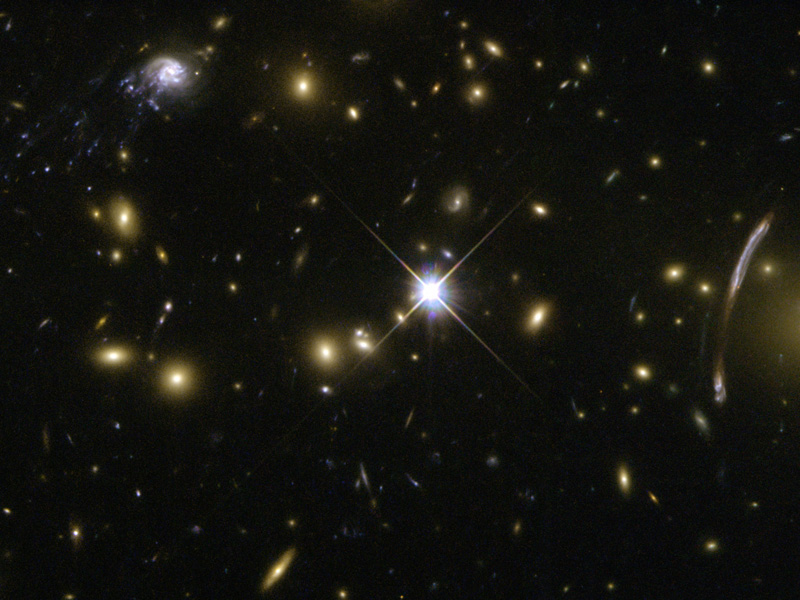
Research Interests: Joanne D Cohn
Physical cosmology:
in particular structure formation and galaxy formation. This has so far included work on galaxy quiescence, mergers (galaxy, galaxy cluster), galaxy clusters (finding them, characterizing them, situating them in the cosmic web), galaxy evolution in clusters and elsewhere, and counterparts at high redshift. I use simulations (mostly dark matter only) and analytic methods.
(The figure source is here.)
Current work
Decoding galaxy formation, creating mock catalogues: Relevant observational data for many of the questions/consequences of models for structure formation and galaxy formation are becoming available or about to become available. Having theoretical predictions with which to compare is becoming more and more useful as the precision of the data allows more discriminating questions. As part of this, it is often crucial to make "mock catalogues" where one creates a simulation that is similar to the observed sky in order to see what observational strategies and analyses may produce/constrain.
These catalogues are usually made from an N-body (dark matter) simulation augmented by assumptions about the correspondence of various objects in the simulation with (some samples of) galaxies and their observable properties. The correspondence is informed and constrained by both theory and observations. I am mostly focussed on large scale structure surveys, where galaxy positions and luminosities are observed; properties such as outflows, AGN activity and morphology are not directly measured. The simulation galaxy samples can be compared statistically to observations. A very interesting route to follow is to note that in the simulation one has galaxy (identified from dark matter properties) histories and environments. So one can study the relation between these properties and possible observations which can decode them (e.g. do quiescent galaxies cluster the same way in observations as galaxies with certain histories cluster within the simulation)?
I am working on this question and on finding (and applying) tests to constrain and improve the simulations. For the latter I have been testing, along with Martin White, many of the simulated sky maps produced for the Dark Energy Survey, and am also part of the validation group for the LSST mock catalogues (as part of the Dark Energy Science Consortium).
Clusters: Galaxy clusters are the largest (and thus rarest) collapsed objects in the universe and correspondingly their counts and clustering are extremely sensitive to cosmological parameters. They are also interesting environments for galaxy formation (and processing) and objects of study themselves for their astrophysical and large scale structure properties. This has inspired many observational cluster surveys, now underway, to collect large samples of them. For counts and clustering, and other uses of galaxy clusters (as environments for galaxy formation, as the most extreme halos/intersections in the cosmic web, etc.), one wants to start with a very basic property of each cluster, its mass. Simulating the counts, positions, mergers and masses of galaxy clusters in dark matter simulations is relatively straightforward nowadays, but going from this to observables, which tend to involve gas physics on some level or another, is more difficult to do precisely. I have worked on comparisons of analytic methods to simulated cluster merger rates, dark matter cluster assembly histories and the roles of major mergers and more recently on more general cluster properties, including measuring their clustering, and finding them in observational data. My most recent cluster work has been on finding and weighing them in simulations, with an eye to understanding what the simulations have to get right in order to use the same finding methods reliably in (specifically optical and SZ) observational data, and there are many interesting questions there to continue pursuing. I am particularly interested in their role in the web and in their relation to the filaments which end upon them. I am part of the Dark Energy Survey cluster working group.
Galaxies/subhalos: A second merger related direction is that of galaxies, which Andrew Wetzel, Martin White and I have been investigating using subhalos in dark matter halos. Galaxy mergers are thought to drive quasar activity, starbursts and the evolution of galaxies into the red sequence, among other things. Identifying these subhalos within dark matter halos is not yet done in a standard way, however these objects are expected to correlate most directly with galaxies, and many observed galaxy properties have been reproduced with this identification. Pushing this analysis further to learn about galaxy evolution and merger properties is a very rich topic, especially at high redshift where observational data is now becoming available.
Reionization: Reionization is the end of the "dark ages", when the universe became ionized again due to photons from structure formation (e.g. stars), at redshifts somewhere between 12 and 6. The role of various possible sources, their strengths and how reionization proceeds are becoming more accessible to observational measurements in the next decade. There are huge numbers of uncertainties involved and characteristic properties of many possible scenarios are being calculated for comparison with these observations. I have worked on the role of mergers in reionization (where the sources that reionize the universe are commonly assigned to only have a photon flux depending upon their mass, rather than whether they have recently merged and are starbursting or hosting an active quasar), putting in various models into analytic calculations with Tzu-Ching Chang. Martin White and I then used numerical simulations to measure merger rates and their scatter more accurately, and more directly compute their effects on reionization. This also gave insight about the high redshift halos and mergers and their comparison to various analytic estimates commonly used, and suggests several future extensions related to reionization.
The most up to date list can be found by looking at my publications .
I've also worked on analytic methods for baryon oscillations, strong gravitational lensing analyses of some systems, and issues to do with analyzing cluster correlation functions, among other things. In the last Millennium I worked on early universe field theory, and string theory.